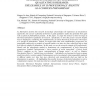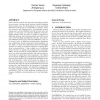1809 search results - page 237 / 362 » On the Purpose of Object-Oriented Analysis |
ECIS
2004
15 years 11 days ago
2004
As Information Systems (IS) research increasingly acknowledges the importance of non-positivist approaches, the case for a plurality of theories to guide qualitative studies has g...
RECSYS
2010
ACM
14 years 11 months ago
2010
ACM
Social network analysis has attracted increasing attention in recent years. In many social networks, besides friendship links amongst users, the phenomenon of users associating th...
BMCBI
2007
14 years 11 months ago
2007
Background: Finding over- or under-represented motifs in biological sequences is now a common task in genomics. Thanks to p-value calculation for motif counts, exceptional motifs ...
BMCBI
2008
14 years 11 months ago
2008
Background: The hierarchical clustering tree (HCT) with a dendrogram [1] and the singular value decomposition (SVD) with a dimension-reduced representative map [2] are popular met...
INFORMATICALT
2006
14 years 11 months ago
2006
Abstract. The asynchronous techniques that exist within the programming with distributed constraints are characterized by the occurrence of the nogood values during the search for ...




